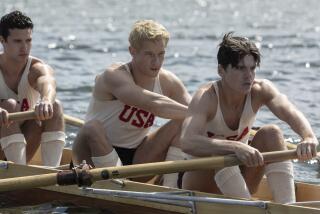War Story : Scenes from the 1983 America’s Cup
- Share via
In terms of excitement, 12-meter racing has much in common with chess. The yachts appear to meander lazily around buoys, employing tactics all but obscure to spectators on boats nearly a mile away. A 24-mile race takes from three to five hours and usually is decided by a matter of seconds. “Born to Win,” the immodestly titled account of the 1983 America’s Cup challenge by Australia II skipper John Bertrand, shows that the America’s Cup is less a race than a bloodless war, a naval engagement between tacticians who maneuver for advantage on a course that changes with each gust of wind.
I tried to downgrade the Americans in the eyes of the younger crew members. “They still have to get the right spinnaker up, and it may take them 12 seconds. It often does. But we are going to hoist ours in eight seconds, faster than anyone has ever hoisted a spinnaker in history. You are going to be better than they are.” It remains the biggest lie I have ever told, but it made those guys believe in themselves as no Australian crew had ever done before.
You can kill yourself on a 12-meter yacht. That is, unless you know precisely what you are doing. The stress loads on some of those halyards, sheets and shrouds is fantastic--in a 20-knot breeze they are stretched steel-tight. With enough rosin on his bow, a decent violinist could probably play “Flight of the Bumblebee” on them.
Again and again they lean into the winches, their arms blurring, precision, never missing a beat. “Tacking!” I call for the 20th time, and the four of them go at it once more. Now I know that they are in the “red zone,” where the pain is becoming so intense it can no longer be tolerated. Again we tack, and again, now for the 25th time. It seems the boys have only seconds to catch their breath when Liberty comes at us again. “Tacking!” I bawl for the 28th time. This time the Americans have had enough, and they track us up to the mark, where we round 1 minutes in front, our biggest margin in the race so far. In the light winds, where brains count for everything, we have them. And in that titanic struggle on the winches, we still won’t give them best.
The breeze is getting up again, and as we head into the America’s Cup buoy, I call for our biggest spinnaker, the 47-footer, pure white and a staggeringly beautiful piece of symmetry. Immediately we feed into some new air and are again bowling along (when) Hughey speaks in a strange voice. “I would not be surprised if they try to ram us, John,” he says. And then it happens. Dennis tacks, and Liberty sets off toward us like a big red torpedo. “It’s his only hope of beating us,” says Hughey, “just to collide.” The upwind boat has the right-of-way, and it is our responsibility to stay clear of him. “We are dealing with a bloody animal here,” I say, as Liberty comes on, straight at us.
They are now within about 1 1/2 boat lengths, nipping at our heels. Suddenly, a voice from Liberty shouts, “We’re getting closer, guys.” All the boys hear that American voice, but it is Chink who decides to reply. He swings around from his grinder, sweat pouring down his face, and bellows: “Come and get us. Come and bloody get us.”
The gun fired signifying the end of the race, and in that very instant, the sails of Australia II fluttered down and the kangaroo with the boxing gloves rocketed to the top of the forestay, a defiant gesture for what everyone knew had just happened. A fleet of boats hurtled toward us with Black Swan out front, engines opened at full throttle. If we had not seen them, we would have heard them, for Phil Judge had the pounding beat of Men at Work at full volume:
Do you come from a land Down Under,
Where women glow and men plunder?
Can’t you hear, can’t you hear the thunder?
You’d better run, you better take cover. 1985 John Bertrand and Patrick Robinson. Permission granted by Hearst Marine Books.
More to Read
Sign up for The Wild
We’ll help you find the best places to hike, bike and run, as well as the perfect silent spots for meditation and yoga.
You may occasionally receive promotional content from the Los Angeles Times.






